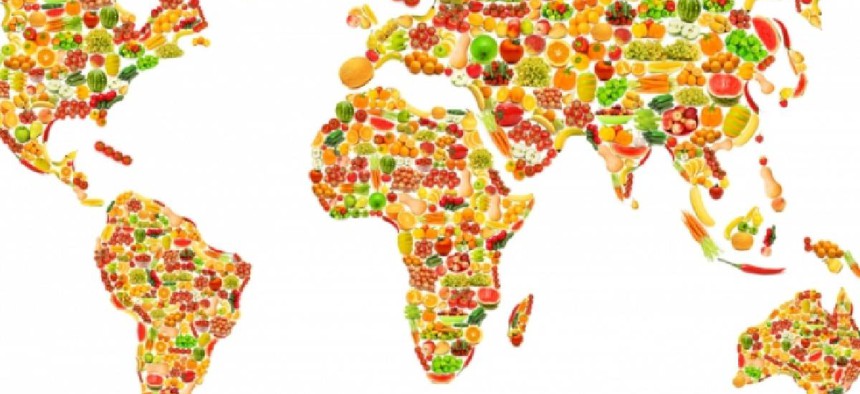Economic Development
Immigration's impact as seen through a trip to the supermarket

Shutterstock
When my parents moved us from Guatemala City to Chester County in the mid-1970s, we were the first Latino family to move into our neighborhood – and, undoubtedly, the first people to chatter with each other in Spanish at the annual oxtail roast at the local firehouse.
The area we moved to was rural, within hailing distance of the towns of Downingtown, Coatesville and Exton, and my mother haunted the supermarkets in each of them, searching for a way to make frijoles volteados, the refried black beans that are part of every Guatemalan meal. It is hard to imagine now, but those stores didn’t stock black beans back then. My mother resorted to scouring the canned soups, looking for Campbell’s black bean soup, with which she could (ingeniously and magically) replicate a passable version of the bean dish she used to call “the Guatemalan caviar.”
But had my mother lived long enough, she would have witnessed a sea change on those Chesco supermarket shelves. Because even more than the sudden (and gratifying) proliferation of small ethnic food shops, there is no easier way to mark demographic changes than by walking into a “general interest” supermarket and noting what is offered in its produce section.
The Giant in Thorndale, for example – which serves residents of Downingtown and Coatesville, in addition to Thorndale – sells cassava, tamarind, plantain and several varieties of papaya in the produce section. Without even looking at an actual demographic breakdown of the three towns the supermarket serves, a culinarily and culturally adept observer can quickly intuit there are probably growing African, Caribbean black and/or Latinx, and Asian populations. The inclusion of Maseca brand cornmeal among the flours and bricks of orange-red achiote paste, made from annatto seeds, among the spices hints at Mexican residents as well.
So, let’s look at the actual demographics. (I used Census Viewer, which includes data from both the 2000 and 2010 census, to track the growth or decline of populations.)
Thorndale itself is 84.91 percent white; 8.89 percent black or African-American; 4.34 percent Latinx; 3.11 percent Asian and less than 1 percent Pacific Islander or American Indian. It hasn’t experienced much growth in the decade between census tallies – in fact, the black/African-American, Latinx, Pacific Islander, American Indian and white populations have all declined. The Asian population has grown by a modest 27.71 percent.
But remember, that supermarket also serves residents in the two adjacent towns, and retail strategies are predicated on growth trends, even when current counts are small.
Downingtown is 79.27 percent white; 12.01 percent black or African-American; 7.19 percent Latinx; 2.74 percent Asian; and less than 1 percent Pacific Islander or American Indian. But, the Latinx population in Downingtown grew 111.57 percent between 2000 and 2010; the very small Pacific Islander population grew by 200 percent; and the Asian and black/African-American populations grew by a more modest 24.14 and 15.75 percentage points, respectively. The white population experienced a decline of 1.47 percent. The very small American Indian population declined by 33 percent.
Coatesville, the third and largest town the supermarket serves, is 46.4 percent black or African-American; 38.03 percent white; 22.96 percent Latinx; and less than 1 percent Asian, Pacific Islander or American Indian. And check out the growth rates between census tallies: 159.09 percent for the Latinx population, 91.23 percent for the Asian population, and whopping 333.33 and 60.53 percents for the small Pacific Islander and American Indian communities, respectively. The black or African-American population grew by 14.5 percent, and the white population by 11.63 percent.
The bitter melons, Indian eggplants, long beans and tamarinds found at Produce Junction in Exton speak to the 229.07 percent growth in the Asian population in the town (5.95 percent of the total population in 2000, 17.53 percent in 2010). Furry-red rambutan fruit and baguette-like bolillos for sale at the Walmart that straddles Chester and Berks counties (it’s located where Elverson and Morgantown meet) reflect the Asian population growth rate of 133.33 percent and Latinx growth rate of 233.33 percent in Elverson, as well as the 137.5 percent Asian growth rate and 200 percent Latinx growth rate in Morgantown.
In 94 percent white Ephrata, a Lancaster County town of the same total population, roughly, as Coatesville, with a Redner’s, Weis, Walmart and Giant all in close proximity to each other, it is even possible to understand the demographics within a growing demographic by looking at the shelves.
At Ephrata supermarkets, not only is Mexican queso fresco – “fresh cheese” – available, so is queso blanco – “white cheese” – from Colombia, and the queso para freir – “cheese for frying” – popular among Dominicans, Puerto Ricans and other Caribbean Latinxs. The fresh cremas – straddling the line between crème fraîche and sour cream – offered for sale are both Mexican and Central American. And at the meat counter, tripe – a popular ingredient in both Mexican menudo and Puerto Rican and Dominican mondongo – is a staple. All of this speaks to the diversity within the Latinx community itself.
Ephrata’s Latinx population grew 91.97 percent from 2000 to 2010. The black or African-American population also grew substantially (56.1 percent) and the Asian population moderately (22.14 percent). The small city’s white population grew less than 1 percent.
Once you start playing the supermarket product demographics game, it is hard to stop. And yes, it is kind of fun. But more, it helps us understand that thinking of any suburban county or central “garden spot” as homogenous and unchanging is to be hopelessly mired in the past.
My mother would have liked the Chester and Berks and Lancaster counties of today. She, like many of us living out this way, would have been delighted to be part of the change that’s been cooking. ■
NEXT STORY: Two Pennsylvanias, one election
